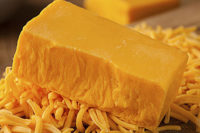
Enzymes and Cultures
by Lori Dahm
How careful selection can speed cheese production and
yield desired functionalities.
The art of cheesemaking is
centuries old, and the science behind cheesemaking is similarly qualified
with decades behinds its study. Few changes have been necessary in either
the art or the science of cheese production within the past 50 years.
However, the effects brought on by the
industrialization of food processing have created the need for greater
productivity and efficiency in the making of cheese. To meet these demands,
manufacturers began using additional enzymes to yield faster cheese
ripening, and adjunct cultures to balance flavor development.
Today, the cheese manufacturing industry is huge, and
the use of enzymes and cultures widespread. Suppliers of the enzyme and
culture ingredients have continued to refine the selection of enzymes and
cultures for specific effects in the final cheese product.
“Enzymes and cultures are not mutually exclusive
systems; they work in very different but complementary ways to yield many
varieties of cheese. Enzymes have a more immediate and specific effect,
while cultures act more gradually to develop the overall cheese
quality,” says Doug Willrett, director of enzymes at Danisco,
Madison, Wis. “It takes the skill of a cheesemaker as well as the
expertise of a culture/enzyme supplier to determine the most appropriate
combination of cultures and enzymes to achieve the desired cheese
product.”
Some of the latest developments and needs in the food
industry have created new opportunities for enzymes or cultures and their
effects in cheese, such as reducing the Maillard browning in mozzarella or
the use of probiotic and prebiotic ingredients.
All told, the use of enzymes and adjunct cultures in
cheesemaking continues to be a developing science in response to the
industry’s need for increased functionalities and efficiencies.
Knowing how to use enzymes and cultures effectively in cheese production is
a complicated proposition, and suppliers of these ingredients continue to
be the hinge pin to navigating through the various manufacturing
considerations.
Faster, Faster
The traditional process of cheesemaking ensues when the
bacteria in the starter culture begin growing by fermenting the lactose in
the milk into lactic acid. In addition, the enzymes that are naturally
present in these bacteria begin breaking down the milk protein, casein. One
of the ways that suppliers of enzymes and cultures are beneficial at this
initial stage of cheese product development is in choosing the appropriate
starter culture.
“The enzymes that digest the proteins are
typically proteases and peptidases that are native to the composition of
the bacterial cells in the starter culture,” says Terri Rexroat,
Degussa Food Ingredients, Waukesha, Wis. “Some bacteria naturally
have more of these protease and peptidase enzymes than other bacteria, so
careful characterization is necessary to select the strains with the
highest level of the desired enzymes.”
As the enzymes drive acidification and also coagulate
the milk, cheese flavor begins naturally developing.
“The critical element is understanding how to
drive the culture and culture adjuncts toward the flavor profile that the
consumer desires. Progress in technology is allowing development of the
detailed understanding of the biochemical pathways cultures and adjuncts
have that contribute to flavor,” says David Burrington, director of
marketing-dairy, at Chr. Hansen, Milwaukee. “This allows us to
understand how to change the flavor profile of the cheese by intent rather
than leaving it to chance.”
The need for faster ripening times in the last 20
years, an effect delivered by the addition of supplemental enzymes
which speed natural flavor development, has changed the natural flavor
development process in cheesemaking, creating a need for adjunct cultures
to balance flavor.
“If you just used the starter cultures and
coagulants [enzymes], there would be natural flavor development. But in
today’s cheesemaking, there is a demand for faster production, which
means flavor development needs to be accelerated as well. Adjunct cultures
and supplemental enzymes help develop the cheese flavor more
rapidly,” Willrett says. “However, faster cheese manufacturing
can result in more bitterness in cheese, so the additional enzymes and
adjunct cultures reduce the bitterness, and accelerate the natural flavor
development in the final cheese product.”
Shortening the cheese aging period via accelerated
ripening of cheese is caused by manufacturers’ desire to realize more
productivity as well as to reduce cheese storage costs. And sometimes
manufacturers add supplemental enzymes and cultures for more targeted
flavor development.
“The adjunct cultures that contain the cheese
ripening enzymes are added to the fluid milk in the cheese vat at the same
time that acid-producing cultures are being added,” Rexroat says.
“They don’t replace the acid-producing cultures because they
are active during the post-cheesemaking ripening phase rather than during
the primary cheese making process. The best approach to ensure selection of
the best adjunct culture for the particular situation is to run several
trial vats using varying adjunct cultures.”
The other purpose that supplemental enzymes and
adjunct cultures have served in recent years is in reduced-fat cheeses,
where the ratio of less fat to protein creates firmer cheese.
“One of the challenges with reduced-fat cheese
products is flavor balance, because the fat/protein/water ratios are
different,” Burrington says. “The complex interaction of
components can yield products that are unbalanced flavor-wise and rubbery
in texture. Careful attention to the culture can help in this regard; you
want to avoid overly proteolytic cultures or enzymes.”
While enzymes can be used to affect the hydrolisis of
the protein substrate in reduced fat cheese products to make them appear
richer in taste and texture, thus far consumers typically find such
products less appealing than their full fat counterparts.
“The trend over the last 25 years has been to
reduce the time to produce cheese, resulting in more cheese from the same
equipment. This increased productivity has been largely made possible by
the advances in culture and enzyme technologies. But there is a limitation
to how fast cheese can be made, and we may have reached a threshold with
currently available technology,” Willrett says. “So we are
continuing to refine the selection and development of cultures and enzymes
which improve the quality of the cheese — in terms of acidification,
flavor development and functionality.”
Atop Pizza
While the use of enzymes and cultures for more rapid
cheese manufacture is a steady development, the mozzarella cheese market is
experiencing a newly emerging need which echoes the trend for faster,
faster, faster.
In the foodservice world, the time allowed for a pizza
to bake is diminishing, as consumers expect their ’za to appear in
shorter time increments than ever. The result is that higher temperature
ovens are being employed to cook the typical pizza, and the Maillard
reaction typical of mozzarella cheese is in need of an adjustment.
“Browning of mozzarella cheese during a pizza
bake or other high heat processes is a result of the high level of the
residual sugar galactose in mozzarella cheese,” Rexroat says.
The industry has been experimenting with adding
adjunct cultures that utilize some of the galactose, which decreases the
Maillard browning after cooking.
“The industry has achieved a
‘whitening’ effect in mozzarella by using adjunct cultures
which ferment some of the galactose, but these cultures often do not reduce
the galactose levels sufficiently to eliminate the excessive
browning,” Willrett says. “We have developed an enzyme that
acts quickly and specifically to utilize the free galactose in mozzarella
cheese, eliminating the over-browning problem. The current challenge is how
best to apply this enzyme during the cheese making process.”
Newest Research
Cultures are also used in fermented dairy products for
certain results and benefits.
“For added shelf life in cultured dairy
products, the most important step is prevention of the growth of
contaminating bacteria,” Rexroat says. “This can be achieved by
adding bacteria that are attenuated [inactivated] but that are still
capable of contributing compounds called bacteriocins that can prevent the
growth of specific undesirable bacteria.”
One of the newest developments in this arena is the
use of cultures in some fluid milk products to extend shelf life.
“On the fresh dairy side, we offer bacteria
protective cultures, which produce antimicrobials that help extend shelf
life and improve the quality of the finished dairy products. These
protective cultures and metabolites have become increasing popular because
of their potential to replace many chemical preservatives,” Willrett
says. “Consumers desire less exposure to chemical preservatives and
are seeking products that are more natural.”
Of course, probiotic cultures are definitely an area
that the dairy industry is keeping a close watch upon, as interest in
probiotics is beginning to accelerate. Experts anticipate that soon
consumer awareness of the health benefits provided by probiotics will reach
a tipping point, and propel great demand for these cultures.
While probiotics will likely gain momentum as
additions to the drinkable yogurts and cup yogurts initially, it also is
possible to include probiotic cultures in many other dairy applications,
including cheese.
Related to this anticipated growth in probiotics,
prebiotics are finding their way into several foods and beverages. A
prebiotic functions by selectively stimulating the growth of probiotics and
other beneficial bacteria in the GI tract.
“The enzyme beta-galactosidase (lactase) can be
used to produce the prebiotic galacto-oligosaccharide (TOS) from
lactose,” Willrett says. “TOS is naturally found in human
breast milk and is added to infant formula and other foods in various
regions of the world to provide the desired prebiotic effect.”
Such advances in enzyme technology are good news for
the world of dairy processing. In the past decade or so, the market value
for whey has increased considerably, as research has demonstrated the vast
health benefits conferred by whey proteins and various enzyme-produced
peptide fractions. While such research has reinforced the value of proteins
in whey, the value of the remaining milk carbohydrate, the lactose, has not
seen a proportional increase in its overall value. Now the potential to
transform some of the relatively low value lactose into higher valued
prebiotics bodes well for the use of the milk carbohydrate.
At the same time, protease and pepidases enzymes have
also been shown to be extremely useful in acting upon whey proteins to
hydrolyze whey into different peptide fractions and subfractions, many of
which confer interesting new functionalities and health benefits.
“For cultures, the future is especially bright
for probiotics,” Willrett says. “As for dairy enzymes,
opportunities for converting whey into higher value peptides and prebiotics
paint a rosy picture for this technology and the dairy industry. I would
place a big bet on that.”
$OMN_arttitle="Enzymes and Cultures";?>
